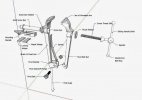Hi Guys,
Is the pitted looking metal jaws still good enough to learn on?
Most of old post vices are either rusty or very pitted on the inside faces of the jaws.
Will these still last a while, or should be avoided.
What would be the maximum for a 5.5" wide jaw, 44" long and 68-78lbs.
Thanks in advance,
Jon
Is the pitted looking metal jaws still good enough to learn on?
Most of old post vices are either rusty or very pitted on the inside faces of the jaws.
Will these still last a while, or should be avoided.
What would be the maximum for a 5.5" wide jaw, 44" long and 68-78lbs.
Thanks in advance,
Jon

